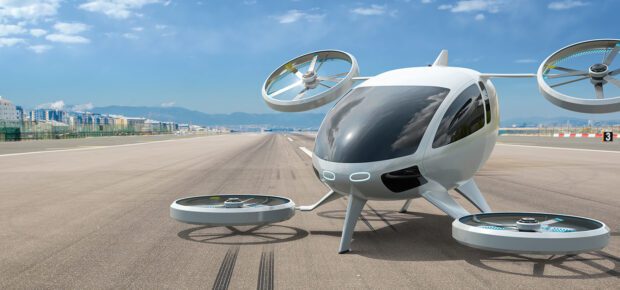October 26, 2023
Millions of people begin and end each work day stuck in traffic. According to the Inrix Global Traffic Survey, drivers in London lost approximately 156 hours to traffic in 2022, while in Bogota, they lost 122 hours.
Wouldn’t it be better if commuters could do something besides drive during that time? Or better yet, hop over all that congestion?
Two technologies, autonomous vehicles and air taxis, offer those possibilities.
“People spend too much time commuting. Autonomous driving means people can do what they want during the commute,” said IEEE Member Ralf Ma.
And with air taxis, well, we wouldn’t be bound to traffic congested roads at all.
2023 brought new developments in the fields, but how close are they to reality?
These technologies are likely to see small, incremental progress in the coming years. While most people won’t have access to them in 2024, they’re closer to a full rollout than you might think.
A Quick Flight to the Grocery Store?
All across the world, startups and governments are working to make air taxis a reality. Among industry insiders, this category of vehicles fall under the label “Advanced Air Mobility (AAM),” which refers to autonomously piloted, electric aircraft, usually with vertical takeoff and landing capabilities. The U.S. Federal Aviation Administration is preparing to support air taxi deployment at one or more sites by 2028. A consortium of researchers in Texas put together a framework for air traffic control. In China, the maker of one air taxi has stated that it expects certification of its vehicle soon.
But we may see air taxis in use before they begin accepting passengers. Manufacturers, and their partners, have begun working to find other applications – like cargo delivery and emergency response – that will give operators the data and experience to perfect their operations.
In “The Impact of Technology in 2024 and Beyond: an IEEE Global Study,” a recent survey of global technology leaders, 29% of respondents said they see advancing the cargo transportation industry by providing faster and cleaner modes of moving packages – both large cargo delivery aircraft and small package delivery drones — as the top benefit of AAM in the future.
Emergency response has also emerged as a likely, near term benefit of AAM.
“Firefighting with planes and helicopters is very dangerous, and very expensive,” said Eleanor “Nell” Watson, an IEEE Senior Member. “Rescue equipment, such as forward-looking infrared (FLIR) cameras are also rare and expensive, with a low loiter time. Being able to perform disaster relief functions autonomously, without trained pilots being necessary, could be a major boon for public safety.”
Level Up
Ten years ago major companies were betting big on autonomous driving, and they promised that the technology was right around the corner. But as time went on, it became clear that autonomous driving was a much harder problem to solve than many of its proponents thought.
“Already, many cities are rolling out self-driving vehicles,” Watson said. “An important caveat is that what works well in one area, may not work well in another. What works well enough in urban Singapore may not work well in rural Zaire.”
Robotaxis, for example, operate in many urban areas, but they usually stay within defined geographic boundaries to limit the likelihood that the car will encounter a situation it isn’t trained for. Mercedes Benz announced the introduction of the first Level 3 autonomous vehicle for the consumer market in 2023 – an important milestone in the development of driverless cars.
“Level 3 autonomous driving implies an ‘eyes off’ system, meaning the driver may use this time in the form of meetings,” said IEEE Senior Member Inderpreet Kaur.
So, how long until most of the cars on the road are capable of this level of autonomy? Nearly half of those in the IEEE survey, 49%, said that the majority of cars sold globally would be autonomous within three to five years, with 22% believing that the milestone would be reached sooner. More than half of respondents – 56% – said they would be very likely to drive an autonomous vehicle in the next five years.
“There was a time when every elevator had a lift operator,” said IEEE Senior Member Nikhil Gupta. “Drivers in cars will be obsolete. The path planning and sensors will make the driving more efficient, accident free and comfortable.”
Learn more: What might air traffic control look like in the era of air taxis? Read about a framework developed by a group of researchers in Texas in IEEE Spectrum.





 Meaningful Momentum or Running in Place?
Meaningful Momentum or Running in Place? AI Through Our Ages
AI Through Our Ages Liquid Infrastructure: Our Planet's Most Precious Resource
Liquid Infrastructure: Our Planet's Most Precious Resource The Impact of Technology in 2025
The Impact of Technology in 2025 Quantum and AI: Safeguards or Threats to Cybersecurity?
Quantum and AI: Safeguards or Threats to Cybersecurity? Why AI Can't Live Without Us
Why AI Can't Live Without Us Bits, Bytes, Buildings and Bridges: Digital-Driven Infrastructure
Bits, Bytes, Buildings and Bridges: Digital-Driven Infrastructure Impact of Technology in 2024
Impact of Technology in 2024 Emerging AI Cybersecurity Challenges and Solutions
Emerging AI Cybersecurity Challenges and Solutions The Skies are Unlimited
The Skies are Unlimited Smart Cities 2030: How Tech is Reshaping Urbanscapes
Smart Cities 2030: How Tech is Reshaping Urbanscapes Impact of Technology 2023
Impact of Technology 2023 Cybersecurity for Life-Changing Innovations
Cybersecurity for Life-Changing Innovations Smarter Wearables Healthier Life
Smarter Wearables Healthier Life Infrastructure In Motion
Infrastructure In Motion The Impact of Tech in 2022 and Beyond
The Impact of Tech in 2022 and Beyond Cybersecurity, Technology and Protecting Our World
Cybersecurity, Technology and Protecting Our World How Technology Helps us Understand Our Health and Wellness
How Technology Helps us Understand Our Health and Wellness The Resilience of Humanity
The Resilience of Humanity Harnessing and Sustaining our Natural Resources
Harnessing and Sustaining our Natural Resources Creating Healthy Spaces Through Technology
Creating Healthy Spaces Through Technology Exceptional Infrastructure Challenges, Technology and Humanity
Exceptional Infrastructure Challenges, Technology and Humanity The Global Impact of IEEE's 802 Standards
The Global Impact of IEEE's 802 Standards Scenes of our Cyber Lives: The Security Threats and Technology Solutions Protecting Us
Scenes of our Cyber Lives: The Security Threats and Technology Solutions Protecting Us How Millennial Parents are Embracing Health and Wellness Technologies for Their Generation Alpha Kids
How Millennial Parents are Embracing Health and Wellness Technologies for Their Generation Alpha Kids Space Exploration, Technology and Our Lives
Space Exploration, Technology and Our Lives Global Innovation and the Environment
Global Innovation and the Environment How Technology, Privacy and Security are Changing Each Other (And Us)
How Technology, Privacy and Security are Changing Each Other (And Us) Find us in booth 31506, LVCC South Hall 3 and experience the Technology Moon Walk
Find us in booth 31506, LVCC South Hall 3 and experience the Technology Moon Walk Virtual and Mixed Reality
Virtual and Mixed Reality How Robots are Improving our Health
How Robots are Improving our Health IEEE Experts and the Robots They are Teaching
IEEE Experts and the Robots They are Teaching See how millennial parents around the world see AI impacting the lives of their tech-infused offspring
See how millennial parents around the world see AI impacting the lives of their tech-infused offspring Take the journey from farm to table and learn how IoT will help us reach the rising demand for food production
Take the journey from farm to table and learn how IoT will help us reach the rising demand for food production Watch technical experts discuss the latest cyber threats
Watch technical experts discuss the latest cyber threats Explore how researchers, teachers, explorers, healthcare and medical professionals use immersive technologies
Explore how researchers, teachers, explorers, healthcare and medical professionals use immersive technologies Follow the timeline to see how Generation AI will be impacted by technology
Follow the timeline to see how Generation AI will be impacted by technology Learn how your IoT data can be used by experiencing a day in a connected life
Learn how your IoT data can be used by experiencing a day in a connected life Listen to technical experts discuss the biggest security threats today
Listen to technical experts discuss the biggest security threats today See how tech has influenced and evolved with the Games
See how tech has influenced and evolved with the Games Enter our virtual home to explore the IoT (Internet of Things) technologies
Enter our virtual home to explore the IoT (Internet of Things) technologies Explore an interactive map showcasing exciting innovations in robotics
Explore an interactive map showcasing exciting innovations in robotics Interactively explore A.I. in recent Hollywood movies
Interactively explore A.I. in recent Hollywood movies Get immersed in technologies that will improve patients' lives
Get immersed in technologies that will improve patients' lives